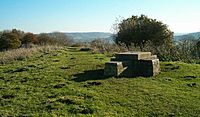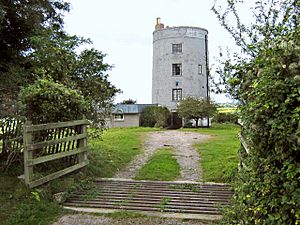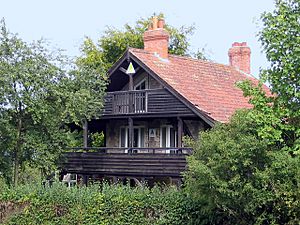Walton and Ivythorn Hills facts for kids
| Site of Special Scientific Interest | |
 |
|
| Area of Search | Somerset |
|---|---|
| Coordinates | 51°06′30″N 2°45′05″W / 51.10828°N 2.75129°W |
| Interest | Biological |
| Area | 34.9 hectares (0.349 km2; 0.135 sq mi) |
| Notification | 1953 |
Walton and Ivythorn Hills are two beautiful hills in Somerset, England. They are located near the town of Street, at the end of the Polden Hills. These hills are a special place known as a Site of Special Scientific Interest (SSSI). This means they are protected because of their important wildlife.
The hills cover about 35 hectares (which is like 86 football fields!). They were officially recognized as special in 1953. Today, the National Trust owns and looks after them, making sure they stay healthy for nature and people to enjoy.
Walton Hill and Ivythorn Hill rise to about 80 meters (260 feet) above sea level. They are made of different types of rock, like limestone and clay. The hills are covered with grassy areas, bushes, and woodlands where trees are cut in a special way called coppicing. This mix of habitats is perfect for many creatures. You can find lots of butterflies, Leafhoppers, Spiders, and even large Great Green Bush Crickets living here.
Over the years, these hills have seen a lot of history. There was a quarry here long ago, and old buildings like Ivythorne Manor and Walton windmill tell stories of the past. Ivythorn Hill was also home to the first youth hostel in Somerset.
Contents
Exploring Walton and Ivythorn Hills
The Polden Hills are a long, low ridge of land, stretching for about 16 kilometers (10 miles). They are separated from the Mendip Hills by a flat, marshy area called the Somerset Levels. The hills are made up of different layers of rock, including limestone and clay.
The highest point on Walton Hill is 80 meters (260 feet) above sea level. Here, you'll find a special stone marker called a topograph. It helps you identify important landmarks in the distance, like the Somerset Levels and the Admiral Hood Monument. This spot is also the start of the Polden Way, a walking path that is about 10 kilometers (6 miles) long.
A Look Back in Time: History of the Hills
Long ago, in 1403, a quarry on Ivythorn Hill provided stone for buildings in Street. Ivythorne Manor is a very old and important building. It was first built in the Middle Ages as a place for monks. In 1488, it was rebuilt by John Selwood, who was the Abbot of Glastonbury Abbey. Later, it became a large country house and was changed and added to over many centuries. On the grounds, there is also an old dovecote, which is a building for pigeons, likely built around 1578.
Walton windmill, located on Walton Hill, was mentioned as "new" in 1741. However, there was a mill on this spot much earlier, in 1342. This windmill was used until 1906. Today, it is a protected historic building and is a private home. There was also another windmill on Ivythorn Hill.
The famous shoe company, C. & J. Clark, once had a small health center on Ivythorn Hill. It was a place for people to rest and get better. In 1931, this building became the very first youth hostel in Somerset. It is still used as a youth hostel today, offering affordable stays for travelers.
The National Trust now owns and manages these hills. They bought parts of Ivythorn Hill in 1988, Walton Hill in 1940, and other parts of Ivythorn Hill and Wood in 1919. Their goal is to protect these special places for everyone to enjoy.
In 1977, Ivythorn Hill was the site of a short-lived festival. People gathered there after summer celebrations at Stonehenge. The local council later asked them to leave.
Wildlife on the Hills
Walton and Ivythorn Hills are home to many different natural environments. These include beautiful calcareous grassland (grasslands rich in lime), scrubland (areas with bushes), and coppiced woodlands. In these woodlands, you can find trees like field maple and ash.
This variety of habitats supports a huge number of small creatures, called invertebrates. Butterflies, Leafhoppers, Spiders, and Soldier Flies are especially common here. You might also spot the Great Green Bush Cricket, which is a large, bright green insect.
Between 2011 and 2013, a special project worked to increase the number of Large blue butterflies on the Polden Hills. This involved planting Wild Thyme, which the butterflies need, and carefully managing how animals graze on Walton Hill.
Images for kids






